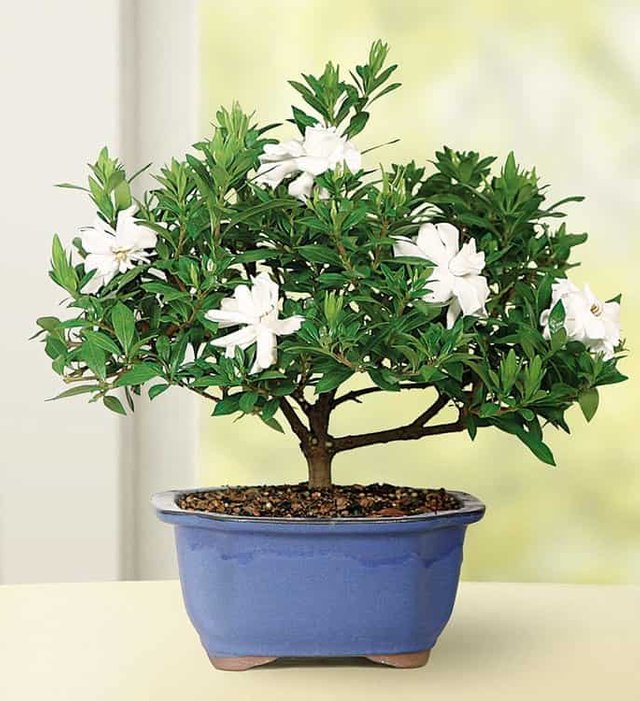Gardenia Bonsai Brussel’s 53805
Gardenia Bonsai is one of the best plants among the different types of Bonsai. It is a very short plant. It is a variation of the Gardenia jasminoides. It is an evergreen plant that is very glossy with beautiful dark green leaves.

General Background: Gardenia Bonsai are one of the most loved and challenging plants in the bonsai world. Beautiful, dark green, oval, waxy foliage and a wonderful fragrance that drifts from showy, creamy blossoms make the Gardenia Bonsai an ideal item to include in your home environment or to present as a unique and special gift to your loved ones. Considered difficult to grow by some gardeners, Gardenia Bonsai offer a unique opportunity for anyone who wishes to take the time to attend to their needs. Gardenia Bonsai are native to southern China and Japan and have been beautifully depicted in the art of those regions for centuries. Trees Features: Gardenia Bonsai are evergreen shrubs with luxurious white or cream colored flowers that are either solitary or form in small attractive clusters. Many species of Gardenia have a very strong scent which is delightful to most but can have adverse effects on people suffering from asthma or allergies. Temperature: Gardenia Bonsai are a tropical plant, and as such require that their environment is warm and humid. During the day, Gardenia Bonsai will prefer a temperature of 68-74 degrees, with a low of 60 degrees at night. In areas with a lot of sun and dry heat or cold temperatures it is advisable to have your Gardenia Bonsai indoors, but with arrangements to ensure that the plant is exposed to good amount of sunlight. Lighting: Gardenia Bonsai can be kept outdoors as it should be exposed to the sunlight for at least 3 to 4 hours each day and when kept indoors it should be placed at a place adequately exposed to sunlight, such as a southern facing window. Watering: It is preferable to keep the Gardenia Bonsai watered regularly to ensure that the soil does not get dry. Since it should be exposed to sun for at least half of the day it will require more frequent watering compared to some other bonsai varieties.
Fertilizing: Gardenia Bonsai are acid loving plants and appreciate being fertilized with a quality acid fertilizer every 4-6 weeks beginning in the spring after the new leaves begin to harden off continuing well into the fall and early winter. Pruning / Training: Pruning of Gardenia Bonsai must be carried out to give the plant a proper shape and size. It is advisable to carry the pruning exercise after it the flowering season has ended. Ensure removal of all the dead leaves and flowers to promote new growth of the Gardenia bonsai. Wiring should be carried out during late winter or spring. Decide on the position or shape a branch is to occupy before bending it. Slowly apply a small amount of pressure with the thumbs, bending gradually, repeating in several locations rather than risk too much in one place. Repeat the process every few days. Be sensitive to any increase or decrease in resistance; wiring should be carried out with attention and patience, ensuring that the wire on the bark is not tightened so hard that the wire leaves marks on it or breaks the branches under the stress of careless wiring. The Gardenia Bonsai is beautifully suited to a variety of training styles such as the classic umbrella style or the ever graceful semi cascade style. Another gardenia pest is the mealy bug. Mealy bugs are the most common gardenia leaf pests you will see. They are white and found in masses along the leaves of the gardenia. They tend to hide themselves along protected areas of the plant. A good home remedy for dealing with mealy bugs is wipe them off by hand and spray your Bonsai with Neem Oil. Other than gardenia bugs, there are a few other gardenia diseases to consider. One of the worst gardenia diseases is sooty mold. Sooty mold is a foliage disease that it turns the leaves of the gardenia black. It doesn’t injure the plant, but it does prevent sunlight from getting to the plant via the leaves, so the plant doesn’t perform as much photosynthesis inhibiting growth. Sooty mold thrives on the honey dew created by gardenia bugs like aphids. If you control the aphids, you will also be able to control sooty mold.